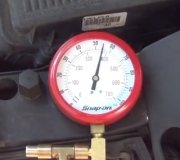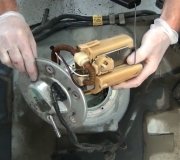The fuel pressure regulator maintains a constant pressure in direct proportion to intake manifold vacuum. This is accomplished by attaching a vacuum diaphragm to the regulator.
When the ignition is switched to "ON" position, but the engine is not cranking, the fuel pump will run for 2 seconds to raise the pressure in the fuel rail and shut off. After the engine has started cranking the fuel pump is turned on.
All fuel pump switching is controlled by the ECU. In case any of the injectors become faulty, this system prevents flooding by limiting fuel pump operation when the ignition is left on.
XJS
During cold starting, additional fuel is injected into the intake manifolds by 2 cold start injectors. These injectors are controlled by the cold start relay and the thermo time switch.
The thermo time switch senses engine coolant temperature, and depending on temperature makes or breaks the ground circuit of the relay. When the starter is activated, the cold start relay is energized with the ground circuit being completed by the thermo time switch.
The thermo time switch also limits the time that the relay is energized (12 seconds maximum). The enrichment provided by the cold start system is in addition to the enrichment resulting from the coolant temperature sensors' signal to the ECU.
If temperature at the thermo time switch is greater than 95 °F (35 °C), the thermo time switch will not close and no cold start enrichment will take place.
The ECU increases injection duration during cranking. This is in addition to any enrichment that is a result of coolant temperature or cold start injection. This enrichment reduces partially after cranking stops and returns to normal after a few seconds. This helps keep the engine running during start-up.
To obtain maximum engine power, it is necessary to inhibit the closed loop control system and enrich the fuel mixture. This is accomplished by using a vacuum operated electrical switch, sensing intake manifold vacuum, and a micro switch, operated by the throttle pulley spindle. The 2 switches are wired in parallel so that either or both switches can signal the need for full load fueling.
The micro switch is mounted so that it is closed when the throttle is opened beyond a certain point. As the throttle is opened beyond this point, the switch signals the ECU that full load fueling is necessary. The micro switch is necessary when the vehicle is traveling at high speeds under full load conditions when intake manifold vacuum is insufficient to close the vacuum operated full load switch.
The contacts of the vacuum operated switch are actuated by a spring loaded diaphragm that senses intake manifold vacuum. When the manifold vacuum falls to low levels due to part throttle full load operation, the diaphragm closes the switch contacts. This causes the fuel system to go into an open loop mode and enriches the fuel/air mixture approximately 12 percent.
Sunday, January 10th, 2010 AT 6:48 AM


